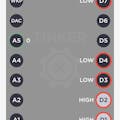Today I describe how the Arduino uses a remote control to pick up the signal via the receiver and then play a melody or a sound on a buzzer and so that you also have an optical control that switches the respective light on an RGB LED. In this example, I reduced myself to buttons 1-3 on the remote control.
Here you can see and hear the corresponding reaction to the push of button 1, 2 or 3:
With a remote control, you can silently trigger a trigger, even over a certain distance of several meters.
The buzzer usually doesn't matter how it's connected: the RGB LED with its 4 pins is different. the longest PIN is connected to GND; the remaining 3 pins each represent a color of red, green and blue. The implementation of the circuit can be found in the sketch.
Here the Uno can also be easily exchanged for other devices. The control of relays could also be realized in this way.
Update with more codes at 13.05.2020HDMI Switch - 3 Port Amplifier Selector - Remote Control
Key 1: "1373912347" + "4294967295"
Key 2: "2351064443" + "4294967295"
Key 3: "713627999" + "4294967295"
IR CONTROLLER - CT-CR201A
1 2 3 4
5 6 7 8
9 10 11 12
13 14 15 16
17 18 19 20
21 22 23 24
- 1 4029248719 -- heller
- 2 16220287 -- dunkler
- 3 16203967 -- OFF
- 4 16236607 -- ON
- 5 2357667384 -- R
- 6 2026743005 -- G
- 7 2724668229 -- B
- 8 2611188417 -- W
- 9 16191727
- 10 16224367
- 11 16208047
- 12 16240687 -- FLASH
- 13 2214874045
- 14 16232527
- 15 16216207
- 16 16248847 -- STROBE
- 17 16189687
- 18 16222327
- 19 16206007
- 20 16238647 -- FADE
- 21 16197847
- 22 16230487
- 23 16214167
- 24 16246807 -- SMOOTH


_ztBMuBhMHo.jpg?auto=compress%2Cformat&w=48&h=48&fit=fill&bg=ffffff)







Comments